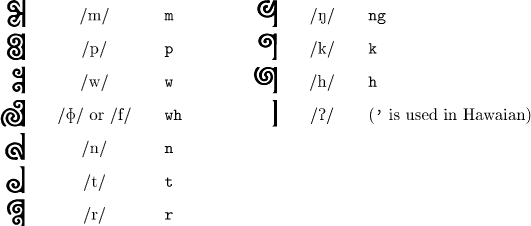The New Maori script is a creation of Ian James. It is an alternative to the Roman alphabet normally used for the otherwise script-less Maaori language of New Zealand.
Part of the aim was to suggest a 'formal' or 'sacred' alphabet for the recording of special poems and songs, while maintaining a local aesthetic in the visual form. In the case of Maori - unlike some languages given it by missionaries - the Roman system is quite effective. So New Maori does not offer benefits of efficiency, simply those of cultural identity.
The Maori language spoken by the aboriginal population of New Zealand and the Cook Islands. May also be used for Tahitian (using /w/ for /v/) and Hawaian (using a subset).
The consonants have a bold, almost solid form, with curling motifs present in both positive and negative space. The solidity reflects the consonantal effect, and the form itself can represent the mouth or origin of the syllable. It may be noted that similar forms can be found in the traditional chin tatoos of men and women. For words which in Roman form begin with vowels, the glottal plosive is presumed to be the functioning consonant. The consonants are listed here with the international phonetic symbol and the usual romanization:

The vowels are lighter in form, and are based on the common motif called koru (representing a young fern frond), and combinations of vowels form a sprouting or branching effect similar to that found in the family of designs called kowhaiwhai. They may also be seen as airy wisps of sound swirling from the mouth.
There are 2 connection points and 2 forms of each primary vowel to allow appropriate connection. Except for long /e/, the long vowels have a small version of the main vowel tucked within. The forms are either upward or downward, in-curling or out-curling. Diphthongs and triphthongs are pronounced quite simply as sequences of 2 or 3 primary vowels. Vowels are given below with the glottal plosive (ie. in initial position):

Some examples of vowel combination:

Because of the similarity of the vowels to some traditional design patterns, elements of the latter may now appear to be spelling out continuous song!


Download a font for the New Maori alphabet (TrueType, 12K)
Contact regarding the author's various script systems can be made via email: ianrjames at hotmail dot com.
Akkhara Muni, Amethyst, Bostani, Elektrum, Fontok, Maui, New Akha, New Maori, New Mong, SIGIL, Sigil Panel Script, Tengwar for Scottish Gaelic, Xylphika